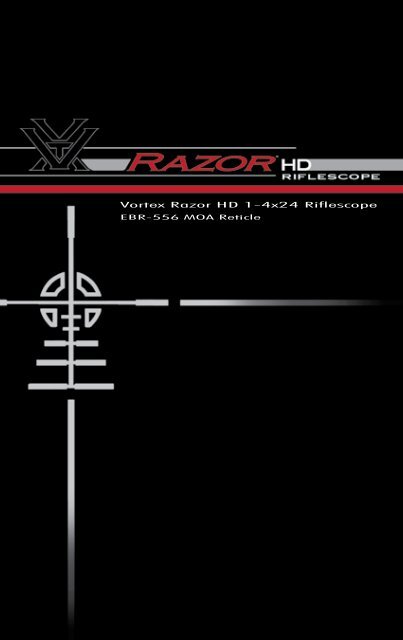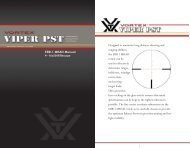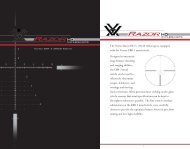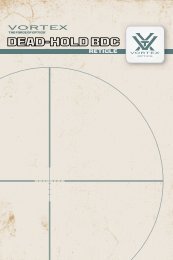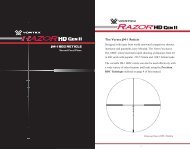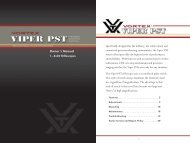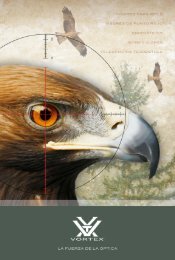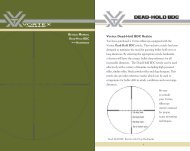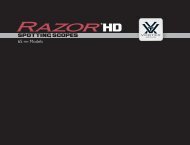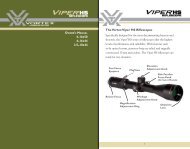Download - Vortex Optics
Download - Vortex Optics
Download - Vortex Optics
- No tags were found...
Create successful ePaper yourself
Turn your PDF publications into a flip-book with our unique Google optimized e-Paper software.
Windage and Elevation AdjustmentsThe <strong>Vortex</strong> Razor HD 1–4x24 riflescope incorporatesprecision finger adjustable elevation and windage dials withaudible clicks.ElevationAdjustment KnobTo make adjustments:• Turn the adjustment dialin the appropriate directionUp/Down or Left/Rightindicated by the arrows.• Move the dials in thedirection you wish thebullets point of impact tochange.WindageAdjustment KnobThe Razor 1–4x24 riflescope uses clicks scaled in ¼ minuteof angle measurements (MOAs) so each small click willmove the point of impact 1/4 MOA. One full MOA equals1.05 inches at a 100 yard distance: ¼ MOA will equal .26inches at 100 yards, .52 inches at 200 yards, .78 inches at300 yards, etc.Example: At a 100 yard sight-in distance, it will take four clicks ofthe knob to move a bullet’s point-of-impact 1.05 inches.75
Radius BarThe <strong>Vortex</strong> Razor HD riflescopes incorporate the patentedRadius Bar to visually assist in keepingtrack of the correct turret knob positionat the rifle’s zero. By watching theposition of the bar during field use, theshooter can quickly verify the correctturret knob position.In a CQB type of situation, the shootercan also use the Radius Bar as a quick visual aimingreference.Sight In section for details on indexing cap.Variable Power AdjustmentTo change magnifications, turn the magnification ringto the desired level. Thepatented <strong>Vortex</strong> MagViewwill provide a low lightreference for magnificationlevel.Radius BarTo benefit from the Radius Bar, the turret cap must beindexed with the zero reference line on turret post. See theMagView68
Illumination AdjustmentThe <strong>Vortex</strong> Razor 1–4x24 riflescopes use a variable intensityreticle illumination system to aid in low light performance.Illumination intensity levels will vary from bright to ultra lowintensity compatible with night vision devices at the lowestsetting.The illumination knob allows for 11 levels of brightnessintensity; an off click between each levelallows the shooter to turn the illuminationoff and return to a favored intensity levelwith just one click. The top six settings(6, 7, 8, 9, 10 and 11) are visible in thedaytime, depending on the backgroundcolor. Settings below 6 are for low lightuse when the user’s eyes have adjusted tolower light levels. Lowest settings are for use with night visiondevices.To change the battery, unscrew outer cap with a coin.Remove the battery and replace with a new one.Illumination KnobParallax AdjustmentThe Razor 1-4x24 series riflescopes are non-adjustablefor parallax correction and are set from the factory to beparallax-free at 100 yards.• At distances under 100 yards, parallax error is less than 1 inch.• At distances over 100 yards parallax error is minimal; usinggood consistent shooting form and cheek weld will prevent mostproblems with parallax.97
Riflescope MountingTo get the best performance from your <strong>Vortex</strong> Razorriflescope, proper mounting is essential. Although notdifficult, the correct steps must be followed. If you areunsure of your abilities, it would be best to use the services of aqualified gunsmith.Centering of the ReticleThe <strong>Vortex</strong> Razor HD riflescope is pre-set from the factorywith the reticle in the center of the adjustment ranges. Ifyou have changed the settings and wish to reset the reticleto the center, this can be done easily:1. Turn the dial (windage or elevation) fully in eitherdirection until stopped. Do not force the dial—as soon as anyresistance is felt, stop turning.2. Carefully counting the dial rotations, turn the dial in theother direction until stopped. Again, stop turning as soon asresistance is felt.3. Turn the dial back again half the amount of rotationscounted and that adjustment will be centered.After this procedure is completed for both windage andelevation dials, the reticle will be approximately centered.10 8
Rings and BasesFollowing the manufacturers instructions, mount a highquality base and rings to your firearm. The <strong>Vortex</strong> Razor1–4x24 riflescopes require 30mm rings. <strong>Vortex</strong> <strong>Optics</strong>recommends using premium quality rings mounting to aone-piece Picatinny base.Ring height for <strong>Vortex</strong> Razor HD 1–4x24 riflescopes willdepend on the firearm and mount being used. Consult thering and base manufacturer for suggested heights.AR15 style rifles will usually require a specialized extra-highmounting height on a cantilever style mount. Most othertraditional rifle or shotgun applications will use a low ormedium ring height.11 9
Eye Relief and Reticle AlignmentBefore the final tightening of the scope ring screws, adjustfor maximum eye relief to avoid injury from recoil.To make the adjustment:1. Set the riflescope to the middle of its magnification range.2. Slide the riflescope as far forward as possible in the rings.3. While viewing through the riflescope in a normalshooting position, slowly slide the riflescope back towardsthe shooter’s face—paying attention to the field of view. Justas the full view is visible, stop.4. Without disturbing the front-back placement, rotate theriflescope until the vertical crosshair exactly matches thevertical axis of the rifle. Use a reticle leveling tool, plumbbob, or an adjustable set of feeler gauges placed between aone-piece base and the flat bottom of the riflescope’s centersection for this procedure.5. After aligning the reticle, tighten and torque the ringscrews down per the manufacturer’s instructions. Usecaution and do not over-tighten.Square the riflescope to the base using flat feeler gauges.Use of an adjustable set of feelergauges between a one-piece baseand flat bottom section of theriflescope to square the riflescope(and reticle) to the base.10 12
Sighting in the RifleBore SightingInitial bore sighting of the riflescope will save time andmoney at the range. This can be done using a mechanicalor laser bore sighter according to the manufacturer’sinstructions. On some rifles, bore sighting can beaccomplished by removing the bolt and visually sightingthrough the barrel.To visually bore sight a rifle:1. Place the rifle solidly on a rest and remove the bolt.2. Sight through the bore at a target approximately 100 yardsaway.3. Move the rifle and rest until you can visually center thetarget inside the barrel.4. With the target centered in the bore, make windageand elevation adjustments until the reticle crosshair is alsocentered over the target.Note: If you are using rings which permit windage adjustments, makeyour initial bore sighting windage adjustments with the rings as muchas possible.13 11
Range Sight-InAfter the riflescope has been bore-sighted, final sight-inshould be done at the range using the exact ammunitionyou expect to hunt or shoot with. The Razor 1–4x24EBR-556 scope is specifically calibrated for the popular5.56x45mm cartridge using 55 gr. bullets and a 100yard zero range. The Razor 1–4 can be used with othercartridges, but be aware that the bullet drop referencesused on the EBR-556 reticle may not accurately match.Before range shooting, be sure the reticle is in focus(see Reticle Focus Adjustment).1. Following all safe shooting practices, fire a three-shotgroup as precisely as possible.2. Next, adjust the reticle to match the approximate centerof the shot group (see section on Windage and ElevationAdjustment).3. If the rifle is very solidly mounted and cannot be moved,simply look through the scope and adjust the reticle until it iscentered on the fired group.4. Carefully fire another three-shot group and see if the bulletgroup is centered on the bullseye.If necessary, make another adjustment to the riflescopeand fire another group to verify zero. This procedure canbe repeated as many times as necessary to achieve a perfectzero.12 14
After the rifle has been zeroed at 100 yards, the elevationand windage knobs should be re-indexed to their zeroindicators. This is a useful feature which allows you toquickly and accurately keep track of elevation or windagecorrections dialed on the turrets in the field and quicklyreturn to an original zero point setting.After completing the final sight-in:• Loosen the threeelevation turret capretaining screws using the2.0 mm hex wrench andcarefully rotate turret capuntil the “0” mark on capmatches up with referenceline on turret post. Be surethat the cap is turning freelyand that you don’t rotate theactual turret mechanism.Correct elevation and windagecap placement.• Re-tighten retaining screws using thumb and forefingeron short end of hex wrench.Repeat procedure with the windage turret.After this adjustment, the turret cap zero marks willcorrespond with the 100-yard zero on the rifle.15 13
Shooting the EBR-556 ReticleThe <strong>Vortex</strong> Razor 1-4x24 EBR556 riflescope isequipped with the patented <strong>Vortex</strong> EBR-556 MOAglass etched reticle. Although this precision reticle hasbeen specifically designed around the 5.56x45 (.223Remington) cartridge using a 55 gr. FMJBT bullet, itcan also be used with similar cartridges. Be aware thatthe further other cartridges vary ballistically from the5.56 round, the further off the bullet drop and windagereference lines will be.Because of it’s unique dual purpose design, the EBR-556MOA reticle can be used at 1x magnification in CQB(close quarters battle) applications or it may be turned upto 4X magnification and used as a precision crosshair forlonger distance shooting.These features are a function of the first focal plane (FFP)reticle design used in this riflescope. Other benefitsto the FFP reticle are accurate use of the ranging andwindage features at all magnification levels and increasedreticle durability due to being located at the springsuspended end of the internal erector tube mechanism.Also, because of the reticle location a FFP riflescopewill have zero point-of-impact shift as magnification ischanged.14 16
For distances inside of 50 yardsFor CQB type applications, use the EBR-556 reticle at1x magnification with a high intensity illumination level.Shoot with both eyes open for maximum speed in targetacquisition. Your eye should view the reticle as simply alarge illuminated central dot.EBR-556 at 1xNote: Heavy non-illuminated lines extend vertically and horizontally inthe field of view to ensure that the shooter still has a rapid aiming point ofreference in case of battery failure.17 15
For distances inside of 50–175 yardsMore magnification may be used if desired and maincrosshairs should be used ina dead-on hold. Actual pointof-impactwill typically be.2 inches below the crosshairintersection at 50 yards, deadon at 100 yards and 2.4 inchesbelow crosshair intersection by175 yards.For distances 200 yards and beyondEBR-556 at 4xFor distance shooting applications, use the EBR-556 reticleat higher magnifications. With the FFP design used inthe Razor 1-4x24 any magnification will allow use of theranging and holdover features, but setting the scope at itshighest 4x magnification will provide the greatest accuracylevel. The EBR-556 reticle is calibrated to give the shooteraccurate bullet drop compensation from 100-700 yards aswell as 10 mph wind drift hold-offs.The main crosshair intersection of the EBR-556 reticleshould be zeroed at 100 yards (see Range Sight-Ininstructions). Due to the flat trajectory of the 5.56mmround, this will allow the central crosshair to be usedeffectively from 0-200 yards on man sized targets.18 16
Note: If you are using the EBR-556 for precision shooting at smalltargets, be aware that there is not a 200-yard drop line. Whenshooting at 200 yards using center crosshair, the bullet will dropapproximately three incheswhen the rifle is zeroed at 100yards.The five horizontallines below the centralcrosshair provide holdoverreferences at 300,400, 500, 600 and 700yards.EBR-556 at 4xClose-up of EBR-556 ReticleEBR-556 Drop Reference marksUse at 0–200 Yards— Use at 300 Yards— Use at 400 Yards— Use at 500 Yards— Use at 600 Yards— Use at 700 Yards19 17
Using the EBR-556 with Other Calibers and LoadsAlthough the Razor 1-4 EBR556 uses a reticle calibratedspecifically for the 55gr. 5.56mm round, it can still beeasily used with many other popular calibers and loads.MOA drop numbers used on the reticle are listed below.Generating a custom ballistic drop chart for other calibersand loads being used will allow the MOA drops to becompared for compatibility.EBR556 Reticle200 Yards – No drop number supplied300 Yards – 4.4 MOA400 Yards – 8.0 MOA500 Yards – 12.5 MOA600 Yards – 18.4 MOA700 Yards – 25.8 MOAExampleThe following drop chart for a .308 (7.62mm) Sierra165 gr. HPBT bullet shot at 2700 fps. was generatedon a ballistic website (JBM Ballistics). As you can see,the drops are quite close to those used on the EBR-556reticle. Up to 500 yards, the difference is generally 1/2MOA or less, and for many applications would allow thereticle to be effectively used with the Sierra .308 HPBT165 gr. bullet.20 18
Custom Drop Chart for Sierra .308 165 gr.Range(Yards)0255075100125150175200225250275300325350375400425450475500525550575600625650675700Drop(MOA)—-2.5-0.20.2-0.0-0.4-0.9-1.4-2.0-2.7-3.4-4.2-5.0-5.8-6.7-7.6-8.5-9.5-10.5-11.6-12.7-13.9-15.1-16.3-17.7-19.0-20.5-22.0-23.521 19
Ranging Distances with the EBR-556 ReticleThere are several unique man-sized ranging featuresused in the EBR-556 reticle. By matching a man’sshoulder width (or any other object spanning 19inches) to the most closely matched reticle image,approximate range can be determined. The followingestimations are based on an average 19-inch shoulderwidth. These range estimations will also work withany other object spanning 19 inches.19”100 YardsThe outer ring dimensionof the illuminated circle(19 MOA) approximatelycorresponds to 19 inches (aman’s shoulder width) at100 yards.200 YardsThe inner ring dimensionof the illuminated circle(8.8 MOA) approximatelycorresponds to 19 inches (aman’s shoulder width) at200 yards.22 20
300 Yards300-yard drop referenceline width (5.7 MOA)approximately corresponds to19 inches (a man’s shoulderwidth) at 300 yards.400 Yards400-yard drop referenceline width (4.7 MOA)approximately corresponds to19 inches (a man’s shoulderwidth) at 400 yards.500–700 YardsThe fine inner line sectionapproximately corresponds to19 inches (a mans shoulderwidth) at these yardages: 500(3.8 MOA), 600 (3.1MOA),700 (2.7 MOA).500-yard example shown.23 21
Estimating 10 MPH Wind Drift with the EBR-556 ReticleThe EBR-556 reticle also helps estimate wind drift usingthe following references:100 to 200 YardsDue to minimal 10 mph wind drift, no reference is provided.300 YardsFlat sides of the inner ring.(2.9 MOA)10 MPH Wind Drift400 YardsCorners between the flatbottom of the circle and theouter circle diameter.(6 MOA)10 MPH Wind Drift24 22
500 YardsOuter edge of the thickhorizontal line section.(8 MOA)10 MPH Wind Drift600 YardsOuter edge of the thickhorizontal line section.(10.4 MOA)10 MPH Wind Drift700 YardsOuter edge of the thickhorizontal line section.(12.9 MOA)10 MPH Wind Drift25 23
MaintenanceCleaningThe <strong>Vortex</strong> Razor riflescope requires very littleroutine maintenance other than periodically cleaningthe exterior lenses. The exterior of the scope may becleaned by wiping with a soft, dry cloth.When cleaning the lenses, be sure to use products that arespecifically designed for use on coated optical lenses.• Be sure to blow away any dust or grit on the lensesprior to wiping the surfaces.• Using your breath, or a very small amount of water orpure alcohol, can help remove stubborn things like driedwater spots.LubricationAll components of the <strong>Vortex</strong> Razor HD are permanentlylubricated, so no additional lubricant should be applied. Ifpossible, avoid exposing your <strong>Vortex</strong> riflescope to directsunlight or any very hot location for long periods of time.Note: Other than to remove the turret caps, do not attempt todisassemble any components of the riflescope. Disassembling ofriflescope may void warranty.24 26
TroubleshootingSighting-in ProblemsMany times, problems thought to be with the scope are actuallymount problems. Be sure the mounts are tight to the rifle andthe scope is secured so it doesn’t twist or move in the rings.An insufficient windage or elevation adjustment range mayindicate problems with the base mount, base mount holes drilledin the rifle’s receiver, or barrel/receiver alignment.Check for Correct Base and Ring Alignment1. Re-center the scope reticle (see Centering of the Reticle).2. Attach bore sighter, or remove bolt and visually boresight rifle.3. Look through the scope. If the reticle appears way off centeron the boresighter image or when compared to the visuallycentered target when looking through rifle’s bore, there maybe a problem with the bases or rings being used. Confirmthat correct base and rings are being used—and in the properorientation.Grouping ProblemsThere are many issues that can cause poor bullet grouping.• Maintain a good shooting technique and use a solid rest.• Check that all screws on rifle’s action are properly tightened.• Be sure rifle barrel and action are clean and free of excessiveoil or copper fouling.• Check that rings are correctly torqued per the manufacturer’sinstructions.• Some rifles and ammunition don’t work well together—trydifferent ammunition and see if accuracy improves.27 25
<strong>Vortex</strong> Service and Repair PolicyUnconditional Lifetime Warranty<strong>Vortex</strong> <strong>Optics</strong> wants you to shootand use your Razor HD riflescopeunder any conditions withcomplete confidence—that’s whyour warranty is straightforwardand simple:• Fully transferableUnconditional LifetimeWarranty• No warranty card needed• No receipt neededRest assured, if this riflescope should ever require repair, allyou need to do is contact <strong>Vortex</strong> for absolutely free service.Call 800-426-0048 or e-mail service@vortexoptics.com.<strong>Vortex</strong> <strong>Optics</strong>2120 West Greenview DriveMiddleton, Wisconsin 53562USAPatents PendingDual Use: Shooting Tactical / Hunting26
#RZR-124-E-13Avortexoptics.com


